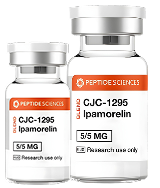Legal Notice Regarding This Product
THIS PRODUCT IS STRICTLY INTENDED FOR RESEARCH USE ONLY. It is designated solely as a research chemical. Usage is confined to in vitro testing and laboratory experimentation exclusively. Information available on our website about this product is for educational purposes only and should not be interpreted as an endorsement or directive for use outside these bounds. Introducing this product into humans or animals by any route is strictly prohibited by law. Handling of this product should be undertaken only by licensed, qualified professionals.
This product is not to be used as a drug, food, or cosmetic. Misbranding, misusing, or mislabeling this product as a drug, food, or cosmetic is illegal. Users are responsible for complying with all applicable laws and regulations regarding the handling and use of this product.
Tβ4 is a major actin-sequestering molecule in eukaryotic cells, and LKKTET was initially reported as a major actin-sequestering site on Tβ4 (2). Several other residues on Tβ4 also contribute to this important activity. An actin-binding site containing peptide with an additional amino acid, LKKTETQ, has several biological functions beyond actin-binding (Table 2). This peptide has been found in wound fluid (46), which suggests that it is a naturally occurring product of Tβ4 degradation and that it may have physiological relevance in wounds and possibly in other normal and pathological conditions. Note that it also induces mast cell exocytosis, which could be important in wound healing. In addition, mast cells may provide additional repair factors (68, 69). This finding could be an important function in early wound healing, which helps to accelerate the wound cascade. It promotes angiogenesis both in vitro and ex vivo (9). Endothelial cell migration and tube formation in vitro have been demonstrated with LKKTETQ. Ex vivo, it promotes sprouting from aortic rings. Sprouting from aortic rings as well as cell adhesion are blocked by addition of soluble actin. One interpretation is that this peptide may function by binding to the actin on the cell surface (45). It is also possible that the actin binding to the peptide blocks accessibility of the cell surface receptor for the peptide. LKKTETQ promotes wound healing in normal rats and in aged mice and appears to be as active as the parent molecule when applied topically to full thickness dermal wounds (70). An unexpected finding was its ability also to promote hair growth when applied topically to rodent skin via activation of existing follicles. Thus, LKKTETQ is a major biologically active site for Tβ4 and the activities with the exception of angiogenesis appear distinct from those of Ac-SDKP.
Table 2. Biological activities of the Tβ4 peptide containing the actin-binding site (aa 17–23)
| Activity | Model |
| Actin binding | In vitro |
| Induces exocytosis | Mast cells |
| Dermal wound repair | Normal rat and mouse and diabetic (db/db) mice, aged mice |
| Angiogenesis | In vitro: endothelial migration, tube formation; ex vivo: sprouting from aortic rings |
| Hair growth | Normal rats and aged mice |
Gabriel Sosne, Ping Qiu, Allan L. Goldstein, Michelle Wheater. “The Actin Binding Site on Thymosin Β4 Promotes Angiogenesis.” FASEB, The Faseb Journal, 23 Feb. 2010, faseb.onlinelibrary.wiley.com/doi/abs/10.1096/fj.09-142307.
TB-500 (TB4-Frag Amino Acid Residues 17–23) 250MCG/Capsule
$99.90

